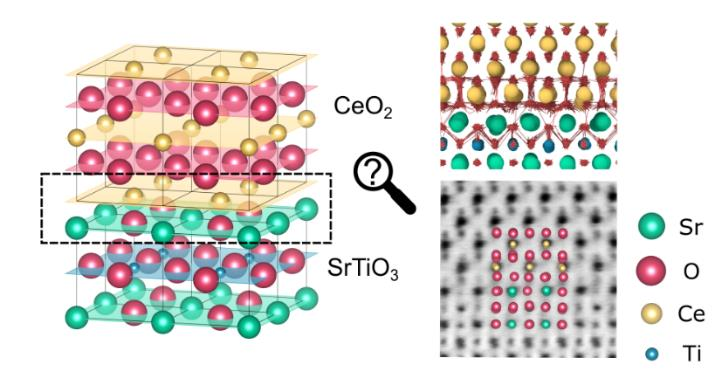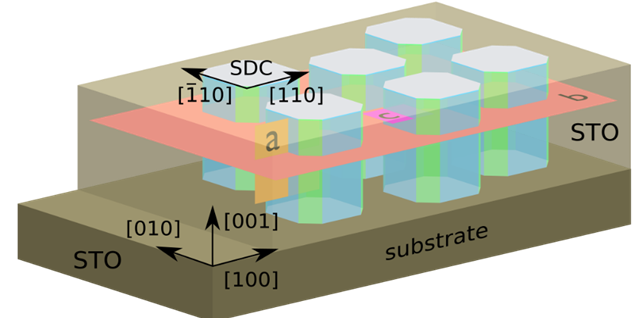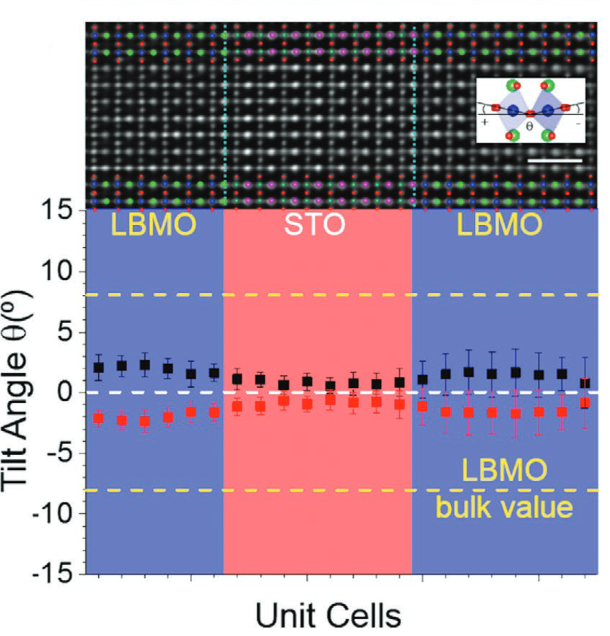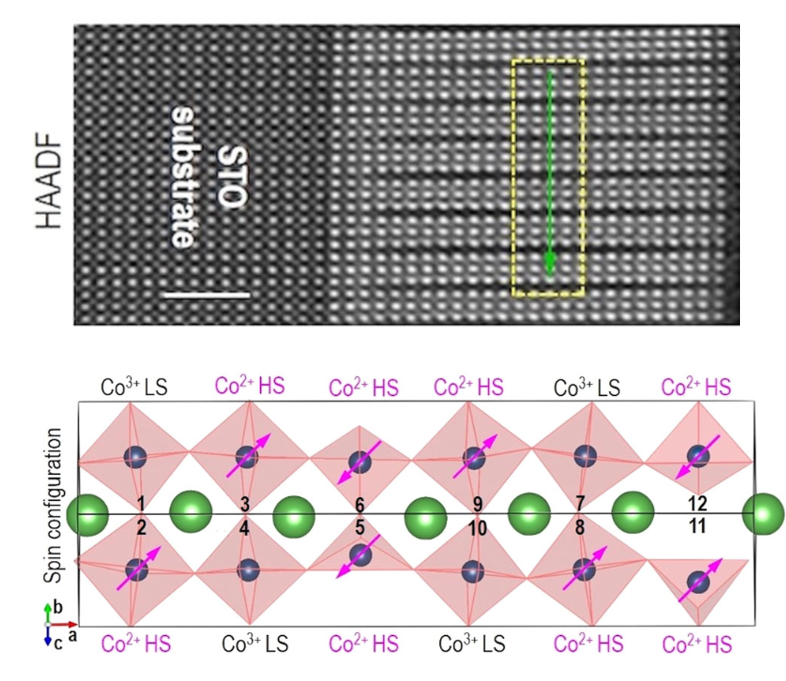Interface structure prediction
Joining two different materials together may give rise to unexpected atomic and electronic configurations [1,2,3]. A few examples include 2D electron gas, enhanced ferroelectric/ferromagnetic properties, interface mitigated fast ionic conductions.
Interfaces between two distinct materials, SrTiO3 and CeO2 in thin films with different geometries.
Emergent properties at interfaces
Emerging properties may arise at atomically thin interfaces due to lattice mismatch, epitaxial effects strain and pinning of tilted octahedra [4,5,6,7].
Left: Pinning of tilted octahedra in La0.9Ba0.1MnO3. Right: Dark streaks in LaCoO3.
References
2024
-
Structure and ionic conduction enhancement mechanisms at CeO2/SrTiO3 heterointerfaces
Bonan Zhu, Georg Schusteritsch, Weiwei Li, and 4 more authors
Applied Physics Reviews, Jun 2024
Fluorite-perovskite heterointerfaces garner great interest for enhanced ionic conductivity for application in electronic and energy devices. However, the origin of observed enhanced ionic conductivity as well as the details of the atomic structure at these interfaces remain elusive. Here, systematic, multi-stoichiometry computational searches and experimental investigations are performed to obtain stable and exact atomic structures of interfaces between CeO2 and SrTiO3—two archetypes of the corresponding structural families. Local reconstructions take place at the interface because of mismatched lattices. TiO2 terminated SrTiO3 causes a buckled rock salt CeO interface layer to emerge. In contrast, SrO terminated SrTiO3 maintains the fluorite structure at the interface compensated by a partially occupied anion lattice. Moderate enhancement in oxygen diffusion is found along the interface by simulations, yet evidence to support further significant enhancement is lacking. Our findings demonstrate the control of interface termination as an effective pathway to achieve desired device performance.
2023
-
Emergent and robust ferromagnetic-insulating state in highly strained ferroelastic LaCoO3 thin films
Dong Li, Hongguang Wang, Kaifeng Li, and 16 more authors
Nature Communications, Jun 2023
Transition metal oxides are promising candidates for the next generation of spintronic devices due to their fascinating properties that can be effectively engineered by strain, defects, and microstructure. An excellent example can be found in ferroelastic LaCoO3 with paramagnetism in bulk. In contrast, unexpected ferromagnetism is observed in tensile-strained LaCoO3 films, however, its origin remains controversial. Here we simultaneously reveal the formation of ordered oxygen vacancies and previously unreported long-range suppression of CoO6 octahedral rotations throughout LaCoO3 films. Supported by density functional theory calculations, we find that the strong modification of Co 3d-O 2p hybridization associated with the increase of both Co-O-Co bond angle and Co-O bond length weakens the crystal-field splitting and facilitates an ordered high-spin state of Co ions, inducing an emergent ferromagnetic-insulating state. Our work provides unique insights into underlying mechanisms driving the ferromagnetic-insulating state in tensile-strained ferroelastic LaCoO3 films while suggesting potential applications toward low-power spintronic devices.
2022
-
Manipulating the metal-to-insulator transition and magnetic properties in manganite thin films via epitaxial strain
Dong Li, Bonan Zhu, Dirk Backes, and 14 more authors
Physical Review B, Apr 2022
Strain engineering of epitaxial transition metal oxide heterostructures offers an intriguing opportunity to control electronic structures by modifying the interplay between spin, charge, orbital, and lattice degrees of freedom. Here, we demonstrate that the electronic structure, magnetic and transport properties of La0.9Ba0.1MnO3 thin films can be effectively controlled by epitaxial strain. Spectroscopic studies and first-principles calculations reveal that the orbital occupancy in Mn eg orbitals can be switched from the d3z2−r2 orbital to the dx2−y2 orbital by varying the strain from compressive to tensile. The change of orbital occupancy associated with Mn 3d-O 2p hybridization leads to dramatic modulation of the magnetic and electronic properties of strained La0.9Ba0.1MnO3 thin films. Under moderate tensile strain, an emergent ferromagnetic insulating state with an enhanced ferromagnetic Curie temperature of 215 K is achieved. These findings not only deepen our understanding of electronic structures, magnetic and transport properties in the La0.9Ba0.1MnO3 system, but also demonstrate the use of epitaxial strain as an effective knob to tune the electronic structures and related physical properties for potential spintronic device applications.
2020
-
Revealing the Structure and Oxygen Transport at Interfaces in Complex Oxide Heterostructures via 17O NMR Spectroscopy
Michael A. Hope, Bowen Zhang, Bonan Zhu, and 3 more authors
Chemistry of Materials, Sep 2020
Vertically aligned nanocomposite (VAN) films, comprising nanopillars of one phase embedded in a matrix of another, have shown great promise for a range of applications due to their high interfacial areas oriented perpendicular to the substrate. In particular, oxide VANs show enhanced oxide-ion conductivity in directions that are orthogonal to those found in more conventional thin-film heterostructures; however, the structure of the interfaces and its influence on conductivity remain unclear. In this work, 17O NMR spectroscopy is used to study CeO2–SrTiO3 VAN thin films: selective isotopic enrichment is combined with a lift-off technique to remove the substrate, facilitating detection of the 17O NMR signal from single atomic layer interfaces. By performing the isotopic enrichment at variable temperatures, the superior oxide-ion conductivity of the VAN films compared to the bulk materials is shown to arise from enhanced oxygen mobility at this interface; oxygen motion at the interface is further identified from 17O relaxometry experiments. The structure of this interface is solved by calculating the NMR parameters using density functional theory combined with random structure searching, allowing the chemistry underpinning the enhanced oxide-ion transport to be proposed. Finally, a comparison is made with 1% Gd-doped CeO2–SrTiO3 VAN films, for which greater NMR signal can be obtained due to paramagnetic relaxation enhancement, while the relative oxide-ion conductivities of the phases remain similar. These results highlight the information that can be obtained on interfacial structure and dynamics with solid-state NMR spectroscopy, in this and other nanostructured systems, our methodology being generally applicable to overcome sensitivity limitations in thin-film studies.
-
Interface Engineered Room-Temperature Ferromagnetic Insulating State in Ultrathin Manganite Films
Weiwei Li, Bonan Zhu, Qian He, and 11 more authors
Advanced Science, Sep 2020
Ultrathin epitaxial films of ferromagnetic insulators (FMIs) with Curie temperatures near room temperature are critically needed for use in dissipationless quantum computation and spintronic devices. However, such materials are extremely rare. Here, a room-temperature FMI is achieved in ultrathin La0.9Ba0.1MnO3 films grown on SrTiO3 substrates via an interface proximity effect. Detailed scanning transmission electron microscopy images clearly demonstrate that MnO6 octahedral rotations in La0.9Ba0.1MnO3 close to the interface are strongly suppressed. As determined from in situ X-ray photoemission spectroscopy, O K-edge X-ray absorption spectroscopy, and density functional theory, the realization of the FMI state arises from a reduction of Mn eg bandwidth caused by the quenched MnO6 octahedral rotations. The emerging FMI state in La0.9Ba0.1MnO3 together with necessary coherent interface achieved with the perovskite substrate gives very high potential for future high performance electronic devices.
-
Atomic-Scale Control of Electronic Structure and Ferromagnetic Insulating State in Perovskite Oxide Superlattices by Long-Range Tuning of BO6 Octahedra
Weiwei Li, Bonan Zhu, Ruixue Zhu, and 11 more authors
Advanced Functional Materials, Sep 2020
Control of BO6 octahedral rotations at the heterointerfaces of dissimilar ABO3 perovskites has emerged as a powerful route for engineering novel physical properties. However, its impact length scale is constrained at 2–6 unit cells close to the interface and the octahedral rotations relax quickly into bulk tilt angles away from interface. Here, a long-range (up to 12 unit cells) suppression of MnO6 octahedral rotations in La0.9Ba0.1MnO3 through the formation of superlattices with SrTiO3 can be achieved. The suppressed MnO6 octahedral rotations strongly modify the magnetic and electronic properties of La0.9Ba0.1MnO3 and hence create a new ferromagnetic insulating state with enhanced Curie temperature of 235 K. The emergent properties in La0.9Ba0.1MnO3 arise from a preferential occupation of the out-of-plane Mn d3z2−r2 orbital and a reduced Mn eg bandwidth, induced by the suppressed octahedral rotations. The realization of long-range tuning of BO6 octahedra via superlattices can be applicable to other strongly correlated perovskites for exploring new emergent quantum phenomena.
2019
-
Determining interface structures in vertically aligned nanocomposite films
Bonan Zhu, Georg Schusteritsch, Ping Lu, and 2 more authors
APL Materials, Jun 2019
Vertically aligned nanocomposite (VAN) films have self-assembled pillar-matrix nanostructures. Owing to their large area-to-volume ratios, interfaces in VAN films are expected to play key roles in inducing functional properties, but our understanding is hindered by limited knowledge about their structures. Motivated by the lack of definitive explanation for the experimentally found enhanced ionic conductivity in Sm-doped-CeO2/SrTiO3 VAN films, we determine the structure at vertical interfaces using random structure searching and explore how it can affect ionic conduction. Interatomic potentials are used to perform the initial searching, followed by first-principles calculations for refinement. Previously unknown structures are found, with lower energy than that of an optimized hand-built model. We find a strongly distorted oxygen sublattice which gives a complex landscape of vacancy energies. The cation lattice remains similar to the bulk phase, but has a localized strain field. The excess energy of the interface is similar to that of high angle grain boundaries in SrTiO3.



